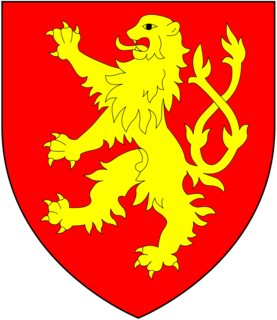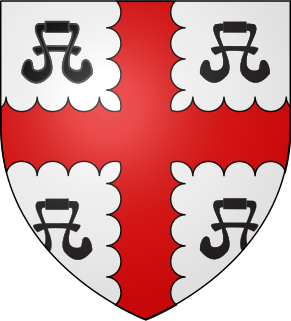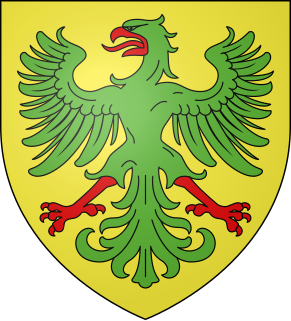
Earl of Warwick is one of the most prestigious titles in the peerages of the United Kingdom. The title has been created four times in English history, and the name refers to Warwick Castle and the town of Warwick.

Earl of Salisbury is a title that has been created several times in English and British history. It has a complex history, and is now a subsidiary title to the marquessate of Salisbury.
Baron Furnivall is an ancient title in the Peerage of England. It was originally created when Thomas de Furnivall was summoned to the Model Parliament on 24 June 1295 as Lord Furnivall. The barony eventually passed to Thomas Nevill, who had married the first baron's descendant Joan de Furnivall, and he was summoned to parliament in her right. Their daughter, Maud de Neville, married John Talbot, who was also summoned to parliament in her right. He was later created Earl of Shrewsbury. On the death of the seventh earl in 1616, the barony fell into abeyance. The abeyance was terminated naturally in favour of the earl's daughter Alethea Howard in 1651 and passed through her to the Dukes of Norfolk. On the death of the ninth Duke in 1777, the barony again fell into abeyance. In 1913 the abeyance was terminated again in favour of Mary Frances Katherine Petre, daughter of Bernard Petre, 14th Baron Petre. Through her father she was a great-great-great-granddaughter of the ninth Baron Petre and his first wife Anne Howard, niece of the ninth Duke of Norfolk, who became co-heir to the Barony on her uncle's death in 1777. On Lady Furnivall's death in 1968 the barony fell into abeyance for the third time.
The title Baron Bergavenny was created several times in the Peerage of England and once in the Peerage of Great Britain, all but the first being baronies created by error. Abergavenny is a market town in South East Wales with a castle established by the Norman lord Hamelin de Balun c. 1087.
Alice Montagu was an English noblewoman and the suo jure 5th Countess of Salisbury, 6th Baroness Monthermer, and 7th and 4th Baroness Montagu, having succeeded to the titles in 1428.

The title of Baron Burghersh has been created three times in the Peerage of England.

The titles Baron Montacute or Baron Montagu were created several times in the Peerage of England for members of the House of Montagu. The family name was Latinised to de Monte Acuto, meaning "from the sharp mountain"; the French form is an ancient spelling of mont aigu, with identical meaning.

The title Baron Bourchier is an abeyant peerage which was created in the Peerage of England in 1342 for Sir Robert Bourchier, who had been Lord High Chancellor of England from 1340–41.
Bourchier is an English surname, from French Boursier, keeper of the purse. Bourchier is the Norman pronunciation.

Baron FitzWarin is an abeyant title in the Peerage of England. It was created by Writ of summons for Fulk V FitzWarin in 1295. His family had been magnates for nearly a century, at least since his grandfather Fulk III FitzWarin had recovered Whittington Castle in 1205. This castle near Oswestry was their main residence and the seat of a marcher lordship. It was regarded as situated in the county of Shropshire since 1536 and also in the Domesday Book of 1086, but for much of the intervening period was regarded as part of Wales.
Elizabeth Frances Philipps, Viscountess St Davids was a British peeress. Following the passing of the Peerage Act 1963, she became the first woman to take her seat in the House of Lords by virtue of an hereditary peerage as 14th Baroness Strange of Knokin.
Edith Maud Abney-Hastings, 12th Countess of Loudoun was a British peeress.
Cecily Neville, Duchess of Warwick, Countess of Worcester was a daughter of Richard Neville, 5th Earl of Salisbury and Alice Montacute, 5th Countess of Salisbury. Her siblings included Richard Neville, 16th Earl of Warwick; John Neville, 1st Marquess of Montagu; George Neville, ; Katherine Neville, Baroness Hastings; and Alice Neville, Baroness FitzHugh.
John Montagu, 3rd Earl of Salisbury and 5th and 2nd Baron Montagu, KG was an English nobleman, one of the few who remained loyal to Richard II after Henry IV became king.
Thomas Cobham, de jure 5th Baron Cobham of Sterborough Castle, and from 1460 de jure 5th Baron Cobham, was an English nobleman.
Alice Neville, Baroness FitzHugh was the wife of Henry FitzHugh, 5th Baron FitzHugh. She is best known for being the great-grandmother of Queen consort Catherine Parr and her siblings, Anne and William, as well as one of the sisters of Warwick the 'Kingmaker'. Her family was one of the oldest and most powerful families of the North. They had a long-standing tradition of military service and a reputation for seeking power at the cost of the loyalty to the crown as was demonstrated by her brother, the Earl of Warwick.

Thomas de Monthermer, 2nd Baron Monthermer was the son of Ralph de Monthermer, 1st Baron Monthermer and Joan of Acre, the daughter of King Edward I of England. He was a first cousin of King Edward III of England.

John de Montacute was a 14th-century English nobleman and loyal servant of King Edward III. He was the son of William Montagu, 1st Earl of Salisbury by his wife Catherine Grandison, and younger brother of William de Montacute, 2nd Earl of Salisbury (1328–1397). He also had several younger sisters.
Margaret de Monthermer was an English heiress and suo jureBaroness Monthermer.





